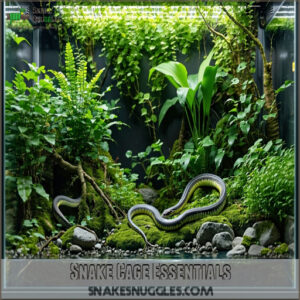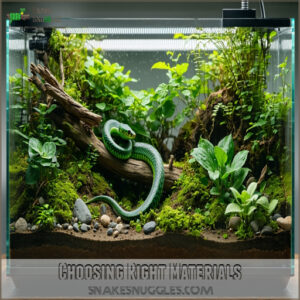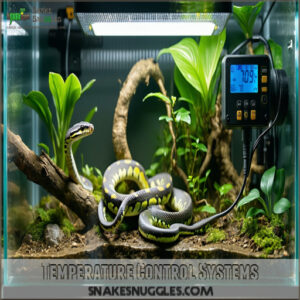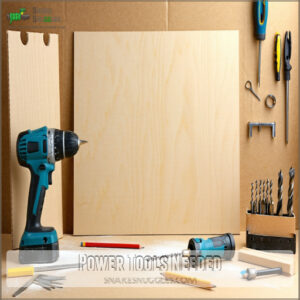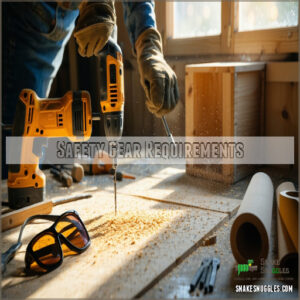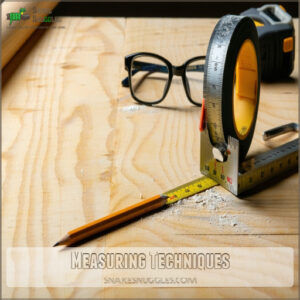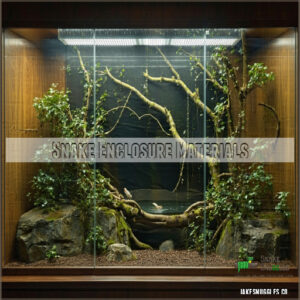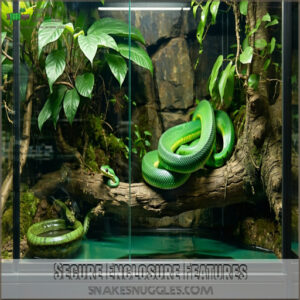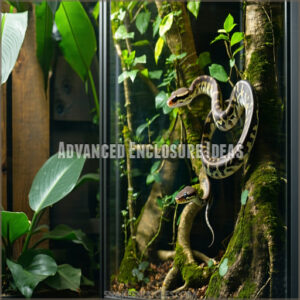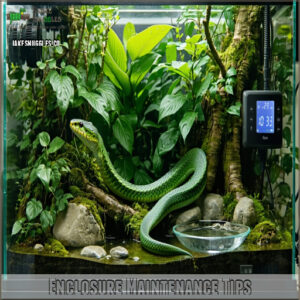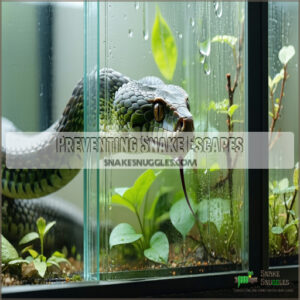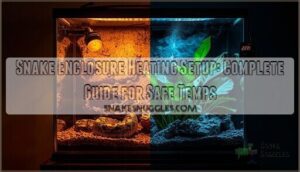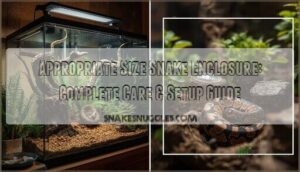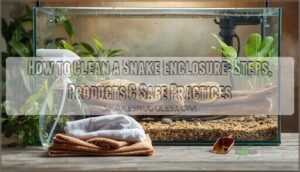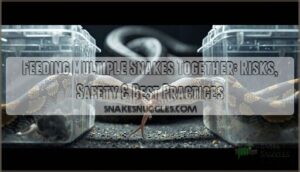This site is supported by our readers. We may earn a commission, at no cost to you, if you purchase through links.
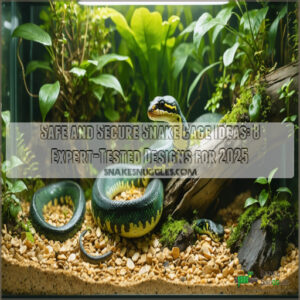
Match the size to your snake’s needs; for example, a 4-foot snake enjoys at least a 6-foot setup.
Use materials like glass, PVC, or melamine-coated wood, avoiding toxic woods like cedar.
Add secure latches, silicone door seals, and good ventilation (think top and bottom vents).
Keep temperatures steady with a thermostat and create a cozy vibe with hides, branches, and a comfy substrate like aspen shavings.
Trust me, a happy snake stays put—unless, of course, you leave the door open!
Table Of Contents
- Key Takeaways
- Snake Cage Essentials
- Safe Enclosure Design
- Enclosure Construction Tips
- Snake Enclosure Materials
- Secure Enclosure Features
- Advanced Enclosure Ideas
- Enclosure Maintenance Tips
- Preventing Snake Escapes
- Frequently Asked Questions (FAQs)
- What is a DIY snake cage enclosure?
- How to build a safe snake enclosure?
- How to secure a snake cage?
- What materials do you need for a snake cage?
- Can you use wire mesh in a snake cage?
- What is a good substrate for a snake enclosure?
- How to secure a snake enclosure?
- How do you make a snake enclosure escape proof?
- How to keep snakes from escaping?
- What not to put in a snake enclosure?
- Conclusion
Key Takeaways
- Measure your snake’s length and provide an enclosure at least twice as long to ensure proper space and comfort.
- Use materials like PVC, melamine-coated wood, or tempered glass, while avoiding toxic options like cedar or pine.
- Install secure latches, silicone seals, and tight-fitting ventilation to make the enclosure escape-proof.
- Maintain steady temperatures with a thermostat and add hides, branches, and a substrate like aspen shavings for a cozy environment.
Snake Cage Essentials
You’ll need more than just a box with holes to keep your scaly friend safe and comfy in their new home.
So let’s start with the must-haves for a proper snake enclosure.
Your snake’s home should be at least twice their length with secure latches, proper ventilation holes, and the right substrate to prevent escapes while keeping them healthy and happy.
Enclosure Size Considerations
Ever wondered how much space your slithery friend really needs?
Your snake enclosure size should match your pet’s full adult length plus half that length for comfort.
For a quick rule of thumb: if you’ve got a 4-foot snake, you’ll want at least a 6-foot enclosure.
Different species have different needs though – arboreal snakes need taller spaces while ground-dwellers need more floor area.
When setting up your snake’s home, consider the proper enclosure ventilation to guarantee a healthy environment.
Secure Construction Materials
To keep your snake safe and sound, you’ll need materials that can handle both moisture and weight.
Start with high-pressure particleboard or quality plywood for the frame – they’re durable woods that won’t warp. Skip any toxic materials like cedar or pine, and opt for non-toxic coatings and safe insulation.
Glass, PVC, and melamine-coated wood are also recommended snake enclosure materials. Remember, secure fasteners and escape-proof latches aren’t just nice-to-haves – they’re essential for your slithery friend’s safety.
Ventilation Requirements
Through your snake cage‘s ventilation requirements, you’ll create the perfect breathing room for your scaly friend.
Strategic ventilation isn’t just about drilling holes – it’s about smart placement and size.
Proper vent placement, as discussed in this DIY enclosure guide, is essential for humidity control and ideal airflow.
- Top corners need vent holes for ideal air flow systems
- Fresh air exchange works best with both top and bottom vents
- Snake cage ventilation holes should match enclosure size
- Keep oxygen levels balanced by avoiding over-ventilation
- Use axial fans in warmer climates for better temperature control
Safe Enclosure Design
You’ll want to build your snake’s home with escape-proof features and high-quality materials, just like you’d childproof a room for a clever toddler.
Your choice of tempered glass panels, secure latches, and proper ventilation will keep your scaly friend safe and comfortable while giving you peace of mind.
Choosing Right Materials
Once you’ve nailed down the size requirements, picking the right materials makes all the difference.
The latest research shows PVC, HDPE plastic, and tempered glass are top choices for 2025.
These nontoxic materials create secure snake enclosures that’ll last for years.
When using wood, stick to water-based sealants and low-VOC coatings.
Your scaly friend will thank you for the safe, cozy home.
Escape Proof Features
Even the best materials won’t matter if you’ve got gaps in your escapeproof design.
Double-door systems with wire locks act as your first line of defense, while silicone door wraps seal those sneaky spaces where your escape artist might squeeze through.
Don’t forget to add secure latches and check regularly for wear—one tiny crack, and your secure snake enclosure could become an impromptu game of hide-and-seek.
Temperature Control Systems
Today’s thermal sensors make temperature control a breeze in your enclosure.
Set up a thermostat-controlled heat source covering one-third of the floor, creating essential temperature gradients from 75-95°F.
You can find a variety of snake cage thermostat options online.
Mount digital thermometers at both ends to track conditions, and add mesh panels for airflow.
For extra control, a small USB fan prevents hot spots and keeps your scaly friend comfy.
Enclosure Construction Tips
You’ll need some basic power tools and safety gear to build your snake’s dream home, so don’t worry if you’re not exactly Bob the Builder.
Before you start measuring and cutting materials for your snake enclosure, make sure you’ve got your safety goggles, work gloves, and a reliable power drill handy.
Power Tools Needed
Let’s get your snake enclosure project rolling with the right power tools.
You’ll need that trusty drill with different-sized bits for ventilation holes and assembly.
Proper enclosure sizing is essential, so follow a custom snake enclosure build guide for your snake’s species and adult size.
Here are the must-haves:
- A dependable jigsaw with fine-toothed blades for precise panel cuts
- A power sander to smooth those rough edges before assembly
- A rotary tool for creating perfect vent holes and custom features
Keep cutting guides handy for those straight, professional-looking cuts.
Safety Gear Requirements
Safety goggles and protective gloves are your non-negotiable buddies when building secure snake housing.
You’ll want a first aid kit nearby – those power tools don’t care if you’re having an off day.
Keep emergency tools handy and post hazard signs in your work area.
For snake cage safety, wear closed-toe shoes and avoid loose clothing that could catch on equipment.
Measuring Techniques
Now that you’ve got your safety gear ready, getting accurate measurements will make or break your snake cage design.
Remember the old carpenter’s saying: measure twice, cut once – it’ll save you headaches later.
- Measure your snake’s fully stretched length, then multiply by 2 for minimum cage size
- Add 20% extra space for growing snakes
- Double-check diagonal measurements for squareness
- Mark cutting lines with a carpenter’s pencil
- Use a speed square for perfect 90-degree angles
Your dimension assessments need to account for ventilation gaps and door clearances, so keep your scale measurements precise.
And hey, don’t forget to factor in space for water bowls and hiding spots when calculating the final length.
Snake Enclosure Materials
You’ll want to pick materials that’ll keep your scaly friend safe and comfy, like high-quality plywood or tempered glass for the main structure, and smooth surfaces that won’t scratch your snake’s sensitive skin.
Whether you’re building a basic box or a fancy custom setup, you’ll need sturdy hardware like secure latches and proper ventilation panels to prevent any sneaky escape attempts, ensuring a safe environment with proper ventilation.
Wood Selection Guidelines
When building your snake’s home, you’ll want to steer clear of cedar and pine – these toxic wood types can harm your scaly friend.
Instead, reach for moisture-resistant options like oak or maple, which offer sturdy construction and beautiful wood grain patterns.
For sustainable woods, birch and beech work great, and remember to seal your wood selection with reptile-safe finishes to protect against humidity and make cleaning easier.
Glass Panel Options
Your snake’s view to the world starts with picking the right panels.
Tempered glass panels win for durability and scratch resistance, while acrylic panels excel at heat retention and lighter weight.
You’ll want 1/4-inch panel thickness for either type, paired with aluminum frame materials.
For further research, explore these snake cage glass panels.
For installation methods, use reptile-safe silicone sealant options and double-check those escapeproof latches match your glass type.
Substrate Types Comparison
In the context of substrate options, you’ll want the perfect bedding materials that keep your slithery friend comfy.
Cypress mulch is fantastic for humidity control and burrowing, while aspen shavings offer great odor control but less moisture retention.
Skip sand, cat litter, and walnut shells – they’re risky for impaction.
For easy substrate maintenance, commercial paper liners work great, though they’re pricier than newspaper or paper towels, and offer a good alternative for easy substrate maintenance.
Secure Enclosure Features
You’ll want to make sure your snake’s home is as escape-proof as Fort Knox, with secure latches, tight-fitting panels, and properly sealed edges being absolute must-haves.
Whether you’re housing a curious corn snake or a muscular ball python, you’ll need the right combination of hiding spots, secure water bowls, and tamper-proof locks to keep your scaly friend safe and sound.
Locking Mechanisms
The right materials deserve the best locking systems to keep your scaly friend secure.
For maximum security, consider essential snake enclosure safety features like tamper-proof locks and reinforced hinges, which can be found at essential snake enclosure safety features, and Modern escapeproof latches come with key-lock security systems that’ll give you peace of mind.
Here are three must-have features for your secure snake cage:
- Stainless steel locks with complex mechanisms
- Double-action safety catches that prevent accidental openings
- Heavy-duty secure hinges with built-in locking points
Don’t let a simple latch be your only defense – upgrade to a fortress-worthy fastening method!
Hiding Spot Ideas
Peace of mind starts with providing your serpentine friend multiple hiding spots throughout their enclosure.
Mix up natural DIY snake hide options like rock caves and plant hides with budget-friendly alternatives such as cardboard boxes and paper rolls.
For a cozy reptile hide setup, place log tunnels in both warm and cool zones.
Your snake cage hides should cover about 30% of the floor space, giving your pet plenty of secure retreats.
Water Bowl Placement
Looking to add the perfect splash zone to your hideout setup?
Bowl Positioning is all about smart Placement Strategies.
Your snake cage design needs a water dish about 1.5 times wider than your snake’s coils, using heavy ceramic for solid snake enclosure security.
Monitor water quality and Snake Hydration by placing the bowl away from heat sources, making weekly cleaning a breeze for exceptional snake hygiene.
Advanced Enclosure Ideas
You’ll love these cutting-edge snake enclosures that combine vertical terrariums with smart temperature controls to give your scaly friend the perfect home.
Whether you’re interested in a custom-built habitat or an automated system that monitors humidity and heat, these modern designs will keep your snake safe and comfy while making your life easier with smart temperature controls.
Vertical Terrariums
With space-saving benefits, vertical terrariums transform your snake’s habitat into a stunning mini ecosystem.
You’ll maximize floor space while creating a layered landscape that keeps your reptile happy and secure.
- Stack heating zones strategically for perfect temperature gradients
- Add climbing branches and ledges to encourage natural behaviors
- Install secure, sliding front panels for easy access while preventing escapes
You’re getting the best of both worlds: a gorgeous display piece and a safe snake cage that fits perfectly in tight spots.
Custom Enclosure Designs
While vertical setups save space, custom snake cage designs let you flex your creative muscles without compromising safety.
Transform old furniture into eye-catching reptile habitats, or build your snake sanctuary from scratch using sturdy materials like wood and glass.
Whether you prefer a rustic wooden enclosure or a modern terrarium design, your unique DIY snake enclosure can complement your home’s style while keeping your scaly friend secure.
Automated Systems
Now that you’ve mastered custom builds, let’s make your snake’s home smarter. Modern snake enclosure automation takes daily care to the next level with incredible precision.
- Sensor technology constantly tracks temperature and humidity, sending alerts to your phone.
- Smart climate control systems maintain perfect conditions automatically. * Programmable misting systems keep humidity just right.
- Automated feeders handle meal schedules without stress. * Remote monitoring lets you check on your snake from anywhere, day or night.
It’s like having a high-tech snake butler at your service!
Enclosure Maintenance Tips
You’ll find that keeping your snake’s home clean isn’t as scary as wrestling with a python in your bathtub.
Just follow our simple maintenance schedule for spot-cleaning and deep-cleaning routines.
With the right pet-safe cleaners and a quick 15-minute daily check, you’ll keep your scaly friend’s enclosure fresh and healthy.
Preventing common health issues that could make your snake feel under the weather is crucial, and by following these steps, you’ll be able to provide a healthy environment, ensuring your snake stays happy and healthy.
Cleaning Schedules
Snake cage cleaning doesn’t have to be a hassle.
Spot-clean daily for waste removal and fresh air flow—think of it as a quick tidy-up.
Every two weeks, undertake regular cleaning, replacing substrate and tackling grime.
Hygiene checks keep your snake healthy, so don’t skip them, as a clean snake enclosure means a happy serpent buddy!
Disinfectant Options
Keeping your snake’s home clean isn’t just about looks—it’s about their health.
Stick to reptile-safe cleaning products like chlorhexidine, hydrogen peroxide, or vinegar.
They’re great at disinfection without harming your buddy.
For a thorough guide, explore detailed enclosure cleaning tips.
Avoid harsh stuff like pure bleach unless diluted.
Bonus tip? Steam sterilization works wonders for cleaning and sanitizing, no chemicals needed.
A safe snake habitat really starts here!
Humidity Control Methods
Cleaning’s covered, but have you checked your snake cage humidity gauge?
A humidity gauge helps you nail it, keeping things cozy.
Use spray misting or a fogging system for steady moisturecontrol.
Water bowls boost humidity too, especially placed near heat.
If it’s too dry, try evaporative cooling.
Humidity sensors are lifesavers—trust them to keep your snake enclosure humidity spot on!
Preventing Snake Escapes
If you want to keep your snake exactly where it belongs, you’ve got to make sure every latch, vent, and corner is escape-proof.
Snakes are sneaky little escape artists, so sealing gaps and securing doors is more important than you might think!
Secure Latch Systems
Escaping snakes? That’s nightmare fuel. Keep them safe and sound by locking down those latches like a fortress.
- Use secure fasteners that won’t budge under pressure.
- Add safety catches or combination snake cage locks for extra escape prevention.
- Verify your locking devices fit snugly, sealing every gap for solid snake enclosure security.
For added security, explore the various snake cage lock options available online.
Peace of mind starts here!
Mesh Ventilation Options
Good airflow keeps your snake healthy, but poorly secured mesh screens are like an open door for escape artists.
Use tightly woven wire grills or secure snake cage ventilation holes with a solid fastening method.
Balance breathing spaces with safety—too big, and they’re out; too small, and ventilation tanks.
Check regularly to prevent sneaky surprises in your escape-proof setup!
Sealing Gaps Techniques
Snakes are like expert escape artists, squeezing through any tiny gap they find.
Start with a silicone sealant to fill cracks and edges, then check for leaks using a flashlight or gentle air from a fan.
Reinforce joints with screws for a snug fit, and inspect crevices regularly, this will help create an escapeproof enclosure.
Pair sealing efforts with secure latches for an escapeproof enclosure.
Frequently Asked Questions (FAQs)
What is a DIY snake cage enclosure?
A DIY snake cage is a custom-built enclosure made from materials like wood, glass, or plastic.
You design it to fit your snake’s size and needs, ensuring proper ventilation, secure latches, and escape-proof construction.
How to build a safe snake enclosure?
Measure twice, cut once, and seal those edges like your snake’s life depends on it.
Use sturdy materials, add vents for airflow, secure latches to dodge escapes, and pick non-toxic, easy-to-clean finishes.
Safety first!
How to secure a snake cage?
Lock those latches tight, double-check gaps, and add escape-proof mesh for vents.
Snakes are sneaky Houdinis, so seal every tiny crevice.
Use sturdy materials and test closures—if you can’t wiggle it, neither can they!
What materials do you need for a snake cage?
Picture building a fortress, not a flimsy shack.
You’ll need sturdy wood like plywood, tempered glass for clarity, screws, non-toxic sealants, solid hinges, ventilation mesh, and secure latches.
Toss in safety gear—it’s non-negotiable.
Can you use wire mesh in a snake cage?
You can use wire mesh in a snake cage, but it’s a tightrope walk.
Always choose fine, durable mesh to prevent escapes or injuries.
Keep edges smooth, and make certain proper ventilation without compromising safety.
What is a good substrate for a snake enclosure?
Think of a snake’s substrate as its comfy mattress.
Aspen shavings, cypress mulch, or coconut husk work great.
They hold moisture, stay clean longer, and feel natural.
Just skip sand or pine—they’re health hazards.
How to secure a snake enclosure?
Keep escape attempts in check with tight-fitting latches, closed gaps, and escape-proof vents.
Double-check those hinges, seal crevices with silicone, and always opt for secure locks.
It’s like babyproofing—just for a slippery escape artist!
How do you make a snake enclosure escape proof?
Snakes are like tiny escape artists, so seal every gap, double-check latches, and pick escape-proof mesh.
Use tempered glass or sturdy panels, and always prioritize tight fits over convenience.
A secure cage equals peace of mind!
How to keep snakes from escaping?
Double-check all latches are locked tight—snakes are escape artists!
Seal gaps with silicone, stick to smooth surfaces they can’t grip, and angled glass keeps them from climbing out.
Secure vents with fine mesh for extra safety.
What not to put in a snake enclosure?
Don’t toss in cedar or pine bedding—it’s toxic.
Skip sharp decorations or small items your snake might swallow.
Also, avoid heat rocks; they can cause burns.
Stick to safe, simple, and snake-friendly supplies only!
Conclusion
Creating a safe and secure snake cage might feel like designing Fort Knox, but it’s totally doable with the right setup.
Just focus on materials that keep your snake cozy and escape-proof, like PVC or glass, with tight latches and good ventilation.
Don’t forget the essentials—temperature control, comfy hides, and a reliable substrate.
A little effort upfront means a happy, healthy snake and no Houdini moments.
With these safe and secure snake cage ideas, you’re ready to go!

